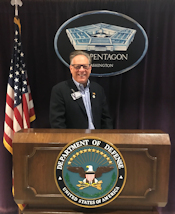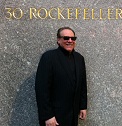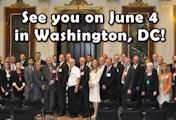NanoBusiness Interview – Douglas Jamison, Chairman & CEO, Harris & Harris Group, Inc.
Posted on January 14th, 2013 in Uncategorized | No Comments »
In this month’s interview, we speak with Douglas Jamison, Chairman and Chief Executive Officer of Harris & Harris Group, Inc. I have had the pleasure of knowing Doug for over 12 years. He is one of the most extraordinary people in our Nanotechnology Community.
Mr. Jamison has served as Chairman and Chief Executive Officer since January 2009; as President and Chief Operating Officer from January 2005 to December 2008; as Treasurer from March 2005 to May 2008; as a Managing Director since January 2004; as Chief Financial Officer from January 2005 to December 2007; and as Vice President from September 2002 to December 2004. He has been a member of our Board of Directors since May 2007. Since January 2009, he has served as Chairman and Chief Executive Officer of Harris & Harris Enterprises, Inc., a wholly owned subsidiary of the Company, since 2005, he has served as a Director; and from January 2005 to December 2008, he served as President. From 1998 to 2002, Mr. Jamison worked as a Senior Technology Manager at the University of Utah Technology Transfer Office, where he managed intellectual property for the University of Utah. This included assessing technologies in both the biological sciences and the physical sciences, working with patent attorneys to develop patent protection, and developing and marketing these technologies with industry. He is a Co-Editor-in-Chief, Journal of Nanotechnology Law & Business and Co-Chair of the Advisory Board, Converging Technology Bar Association and a member of the University of Pennsylvania Nano-Bio Interface Ethics Advisory Board. He was graduated from Dartmouth College (B.A.) and the University of Utah (M.S.).
In our interview, we discuss Doug’s short and longer term outlook for nanotechnology. We hope you enjoy the interview.
– Steve Waite, Director of Research and Strategy
SW: It is a pleasure to speak with you today, Doug. We thank you for taking time out of your busy schedule to speak with us. Harris & Harris Group has been investing in nanotechnology for over a decade. What are the some of the significant developments you’ve seen during that period that have had a positive effect on nanotech commercialization?
DJ: The first decade in the commercialization of nanotechnology has provided a steep learning curve and a lot of exciting breakthroughs. As early-stage venture capitalists there have been four key lessons for Harris & Harris Group over the past decade. First, it has been difficult to extract value from companies developing only nanomaterials. We have found much more success when companies move up the value chain and provide a component or system level solution. There are plenty of opportunities for nanomaterial producers, but it has been difficult to demonstrate sustained value for shareholders, unless a non-commoditized application is identified and successfully commercialized. More and more companies understand this and thus the opportunities for system level solutions that are powered by nanotechnology are increasing. Second, nanotechnology is evolving into application spaces that are enabled by nanotechnology. The companies that are excelling are combining the knowledge of nanotechnology enabled breakthroughs with management teams that have expertise in the application spaces. Identifying the application spaces that are being impacted by nanotechnology now will be the key to making money in nanotechnology over the next decade. Third, major corporations have evolved to have well articulated needs and strategies for working with innovation at the nanoscale. The support of leading corporations is resulting in the acceleration of products coming to the market. I believe this trend will only accelerate into the next decade. Fourth, leading global corporations are purchasing the leading nanotechnology start-ups for fair prices. This last trend excites us at Harris & Harris Group the most.
SW: What are the notable shifts during the past decade that have had a negative effect on nanotech commercialization?
DJ: The most notable negative shift has been the total abandonment by Wall Street and the financial sector of 1) nanotechnology and 2) of small, innovative, early-stage growth companies in general. This isn’t a nanotechnology phenomenon alone. The financial sector has evolved in the direction of short term trading occurring at ever greater speeds and away from long term investing. This has had an impact on true scientific innovation and bodes ill for America retaining any type of world competitiveness. Nanotechnology and the companies commercializing nanotechnology require long development time frames that are inconsistent with the time frames and the focus of the financial sector currently. Fortuitously, we are seeing corporate partners step in to provide some cushioning to the failure of the capital markets.
SW: The past couple of years have been favorable in terms of liquidity events for Harris & Harris following a long drought of inactivity extending back to 2004. How is 2013 shaping up in terms of potential liquidity events?
DJ: Harris & Harris Group had one of the best years in its 30 year history in 2011 with five liquidity events, two of which provided very nice venture-type returns. We were hoping to have one or two more liquidity events in 2012, and as we have disclosed in our public filings, we have multiple companies in the process of considering liquidity opportunities. However, with all the uncertainty in the macro-environment, the uncertainty surrounding American political decision making, and because these companies weren’t in need of capital to execute on their plans, the liquidity events have been pushed back into 2013 and 2014. We believe 2013 will provide more liquidity events and that 2014 and 2015 will also be good years for Harris & Harris Group. As always, none of this is certain, and these events will be subject to macro-economic events as well as each company’s ongoing performance.
SW: Several Harris & Harris Group portfolio companies have been acquired by large, established companies such as DuPont and Amgen in the past couple of years. Do you expect to see continued interest in nanotech from larger, established companies in the year ahead and beyond?
DJ: As I mentioned previously, large, established corporations from the life sciences to electronics to energy to defense have well articulated nanotechnology strategies. These companies understand that breakthroughs occurring at the nanoscale are providing disruptions that can lead to improved products as well as next generation transformative products. I believe this will only accelerate over the next decade. At Harris & Harris Group, more than two thirds of our companies have strategic investment and strategic development agreements with major corporations. As of September 30th, six companies are planning for potential liquidity events, some of which involve discussions with these same corporations. The fact that major corporations such as Amgen, DuPont and Asahi Kasei are purchasing these smaller transformative nanoscale enabled companies is support that this thesis has “legs” going forward.
SW: Looking at your current portfolio, what early-stage companies are you excited about and why?
DJ: This question is like asking a parent which child he or she is most excited by. The answer is we are excited by all of them. Honestly, the hardest thing to do in venture capital is to put good, hard cash into a risky start-up company that has a greater chance of failure than success. Thus, to be truly honest, it is probably the last company we invested in that we are the most excited by, as we had to depart with that cash. We have not announced our most recent very early stage investment, and it is an exciting one in the agricultural space, so readers will need to wait to see what we are perhaps most excited by at this moment in time.
Two of our early stage companies that are beginning to accelerate their businesses, and we believe have the potential to provide venture-type returns, are D-Wave Systems and Adesto. D-Wave has developed and sold the world’s first quantum computer. The purchaser was Lockheed Martin. Adesto is developing a next generation semiconductor memory technology and as part of its growth strategy recently purchased a division of Atmel. Both companies are poised for growth. Finally, Xradia, one of our cash-flow positive companies just completed another record-breaking year of revenue growth. We are finding that business is good for many companies in our portfolio.
SW: What segments and nano-enabled applications look especially promising as new early-stage investment opportunities?
DJ: As we look forward to the next decade of investing, we are excited by the potential of nanoscale-enabled breakthroughs in life science applications. We are living through an unprecedented rate of change in our understanding of biological systems and the ability to manipulate the fundamental building blocks of nature. Novel, rapidly maturing discovery, characterization, analysis, control and manufacturing techniques have a profound impact on life sciences and related industries. Trends generating disruptive investment opportunities include:
– Healthcare budgets are out of balance globally, with aging population jeopardizing the financial viability of the leading economies of the world.
– The ubiquity of data and the Internet both stationary and, increasingly, mobile. For the “always on” society, handheld devices become a natural access point for communication and data sharing between healthcare service providers and their patients.
– Continuing growth in population and global improvements in the quality of life keep driving demand for raw materials, water, food and energy. This demand cannot be adequately met with conventional methods of manufacturing, generation, mining or harvesting. Biological pathways are becoming economically viable and ecologically preferable for production, utilization, and disposal/remediation.
These three macro-trends stand to impact and to provide opportunities in multiple industries, including healthcare, chemical, bioprocessing, water, agriculture, industrial biotech, food and nutrition and energy. These industries will require new technology enabled at the nanoscale to remain competitive. These new technologies will increasingly arise from multi-disciplinary expertise in areas as diverse as biology, chemistry, materials science, electronics, computer science, physics, mathematics and engineering.
We believe the convergence of these three macro-trends, with both the industries that stand to be impacted and the growing trend towards multi-disciplinary expertise, provide a unique investment opportunity in multi-dimensional life science innovations, including 3-D biology, nanofabrication, nanofluidics, biosensing, bioelectronics, big data and wireless, bioimaging, molecular engineering and synthetic biology.
SW: What are some of the key things you look for in companies when considering making new, early-stage nanotech investments?
DJ: Getting to an investment decision is more of an art than a science, which we realize is difficult for entrepreneurs to hear. That said, strong application driven managements are a must. Strong intellectual property is a must. A strong technology team, often out of top research institutions and with access to thought leaders in the field is important. Also, any problem is difficult to solve, and if a company is successful, it is important that it be a problem that can have a big impact in a large market. It is always baffling to me why someone would want to spend time on a difficult problem that didn’t have the opportunity to change the world if it was successful.
SW: We have seen some substantial changes in the venture business over the past decade. What role do you see venture capital playing in fostering the development of nanotech in the U.S. in the years ahead? Where does Silicon Valley fit into the equation?
DJ: The other day I read that seed funding decreased nearly 50% to four percent of financing last year. I think the financial sectors’ ability to find and invest in innovation in the hard sciences – life sciences, chemistry, advanced materials, engineering and physics – has diminished over the past decade. The development time is too long for a financial sector that is fixated on IRR at the expense of innovation. This will ultimately revert to a mean, but in the near term, it has provided a dearth of funding for exciting truly innovative ideas.
As we look forward over the coming decades, we believe corporate partnerships are going to become increasingly important. Facing a depleting pool of acquisition targets and the necessity to supplement their downsized internal R&D, large corporations are actively stepping into the venture game. A combination of 1) rapid development capabilities of small companies, and 2) manufacturing expertise and channel access of large corporations has become exceedingly powerful. For a venture investor and a start-up company, the early engagement with corporations opens doors for expertise, cost savings, market access and liquidity.
We believe the most effective partnerships will be those where the start-up companies bring new technology and ideas to the partnership and where the corporations bring access to scale and manufacturing and end markets. Active corporate involvement is becoming necessary, especially as technology becomes more complex, for proper scale and manufacturing and for efficient access to end markets.
SW: Your mentor Charlie Harris preached long-term thinking, eschewing short-term fixes in favor of long term solutions. It seems as if many investors have become increasingly myopic. How problematic is this for Harris & Harris and its portfolio companies going forward?
DJ: It is certainly problematic as we try to find other investors to invest beside some of the exciting companies that we see daily. That said, we have adjusted our investment strategy and sought new partners. We are not having any difficulties finding good companies, and this myopic behavior on the part of many financial investors is providing great opportunities to invest that otherwise would not exist. It is difficult to swim against the stream, but it also can be very rewarding if one is prudent and survives to reap the rewards.
SW: One final question for you today. What advice would you give to companies seeking early-stage financing in nanotech today?
DJ: Talk early to corporations and corporate venture groups. Some of the smartest young investors are heading to the corporate sector, taking their venture capital skills with them. These people understand venture capital and often understand the technologies and markets better than many of the financial investors. There are the obvious pitfalls that have existed between start-ups and corporations for decades, but these corporate groups are changing, some are becoming more entrepreneurial, and many are attracting the up and coming talent. For us, a good syndicate of investors often includes one other financial investor and one corporate partner, even at the earliest stage of investment.
SW: Thanks again for your time, Doug. It was a pleasure speaking with you. We wish you and your colleagues at Harris & Harris Group all the best in the year ahead and beyond.
NANO NEWS
In case you missed this big story that occurred 2 days after Christmas . . .
Lisa Jackson, Head of EPA Resigns
Thursday, December 27, 2012
http://www.huffingtonpost.com/2012/12/27/lisa-jackson-resigns-epa-administrator_n_2370019.html
Nanotechnology: “What About the Next 60 Years?” (OSTP/PCAST Report)
J. Steven Rutt, Partner, Foley & Lardner LLP
http://www.jdsupra.com/legalnews/nanotechnology-what-about-the-next-60-48233/
Winston-Salem to be host for nanotechnology conference
http://wraltechwire.com/winston-salem-to-be-host-for-nanotechnology-conference-/11886345/
Sony launches the Bravia KDL-W900A LED connected 3DTV at CES
http://www.engadget.com/2013/01/07/sony-bravia-kdl-55w900a/
Waterproof Your Smartphone By Dipping It In Nanotechnology
http://origin.earthtechling.com/2012/12/waterproof-your-smartphone-by-dipping-it-in-nanotechnology/
Happy New Year!
Regards,
Vincent Caprio “Serving the Nanotechnology Community for Over a Decade”
Executive Director
NanoBusiness Commercialization Association
203-733-1949
vincent@nanobca.org
www.nanobca.org
www.vincentcaprio.org




